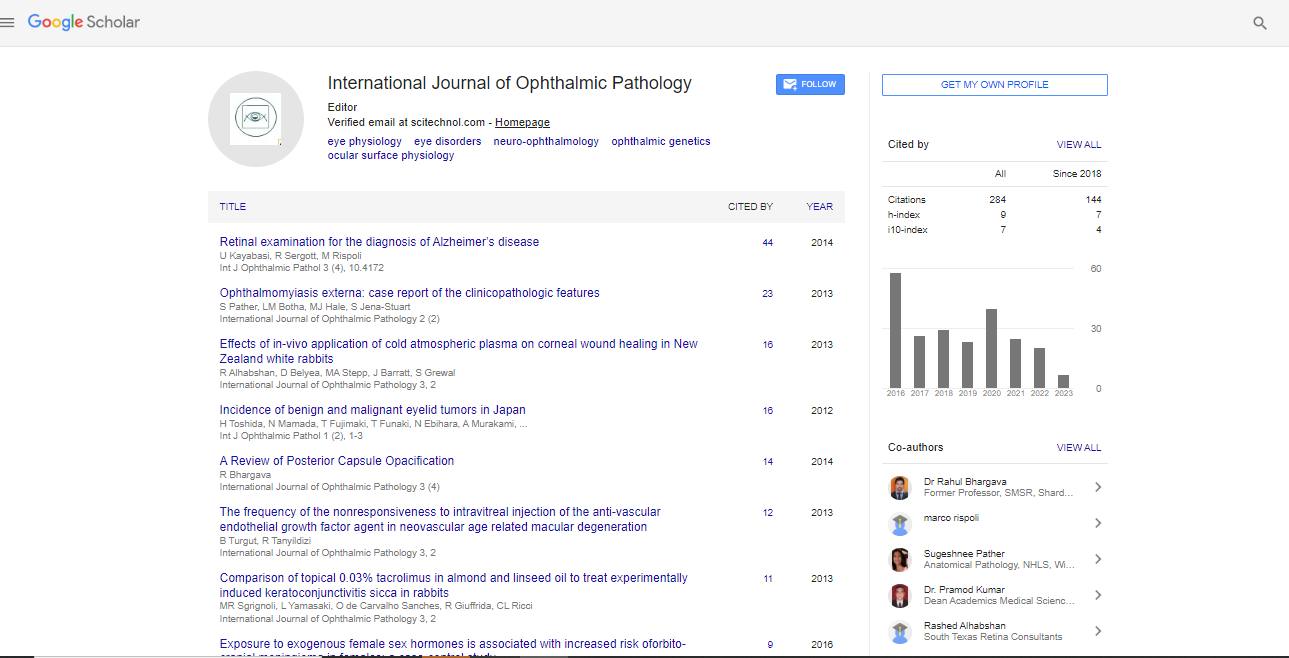Prevalence and factors associated with dry eye in chronic glaucomatous patients followed at the Garoua regional hospital-Northern Cameroon
Josiane Mare Njoya*, Doddo Balkissou, Bra’Eyatcha B. Noelle, Caroline Tsimi Mvilongo, Viola Dovhoma, Godefroy Koki, Lucienne Bella Asumpta and Come Ebana Mvogo
University of Garoua, Cameroon
University of Yaoundé I, Cameroon
: Int J Ophthalmic Pathol
Abstract
Introduction: Ocular surface disease frequently co-exists with glaucoma and may be initiated or exacerbated by topical glaucoma medications. The aim of our work is to evaluate dry eye disease in patients diagnosed as glaucomatous at the ophthalmology department of the Garoua regional hospital in northern Cameroon during the study period. Materials and methods: We conducted a cross-sectional study over a period of 6 months from October 2022 to March 2023. Considering the prevalence of glaucoma at 5.5% according to the study, the population of Garoua is estimated at 361,000 inhabitants, a level of confidence at 80%, the size of the he sample calculated by Open Epi Version 3.01 software Updated on 06/0/2013 2013/04/06 was 35 patients were included in our study, glaucomatous patients followed and treated with hypotensive eye drops for at least 3 months, aged at least 15 years, having given their oral and/or written consent and able to answer the OSDI questionnaires (Ocular Surface Disease Index). Excluded were patients with eyelid abnormalities, eyelid surgery or recent eyelid trauma less than three months under hypotensive drops, as well as patients with a recent infection less than three months old. Ocular surface or ocular surface trauma or cataract surgery or glaucoma less than 15 years old patients with ocular pathologies likely to alter their visual function and finally patients with cognitive or sensory abnormalities. The study was carried out in the ophthalmology department of the Regional Hospital of Garoua (RHG). Garoua Regional Hospital is a third category hospital in the North Cameroon region. RHG's ophthalmology department is an ophthalmological consultation and exploration unit. It is run by two ophthalmologists assisted by two senior ophthalmology technicians and two nursing assistants. An average of 3,000 patients is consulted there per year. The prevalence of glaucoma for the patients consulted is around 1.3%. We summoned all these patients via telephone calls and those who answered present were selected according to the inclusion criteria and exclusion. Patients responded to a French version of the OSDI score. Patients reported the type and number of eye drops used for glaucoma treatment. An ophthalmological examination including the best corrected visual acuity, the intraocular pressure measurement, the examination of the eyelids, the conjunctiva, the cornea and a BUT break up time test was carried out in order to evaluate the tear film and the corneal lesions and conjunctival. Statistical analyzes were performed using IBM SPSS Statistics for Windows, Version 23 from 2015 (IBM Corp., Armonk, New York, USA). Authorization and ethical clearance in the HRG ethics committee were obtained. Results: A total of 43 patients were included. The average age was 47.67 ± 16.27 years with 45.7% women and 54.3% men for a sex ratio of 0.8. The average duration of antiglaucoma treatment for our patients was 3 years. 65.1% of patients presented with dry eye according to the OSDI scores.67.8% of patients with an OSDI score in favor of dry eye were over 40 years old. There is an association between age over 40 years and dry eye according to the OSDI score for p<0.05. 88.6% of patients had a BUT considered abnormal in the right eye and 85.7% in the left eye. 76.7% of patients used eye drops stored in BAK for their antiglaucoma treatment 55.8% of patients had meibomian gland obstruction, 70.8% who had meibomian gland obstruction had dry eye according to the OSDI score. 62.7% of the patients had duration of treatment greater than one year and 71.4% who instilled the hypotensive drops for more than one year presented dry eye according to the OSDI score. Conclusion: Dry eye according to the subjective criteria of the OSDI score and clinical examination of the eyelids, conjunctiva, cornea and by the BUT test. The factors associated with this dryness are: age greater than 40 years, use of stored eye drops; obstruction syndrome is common in chronic glaucomatous patients followed in our department of the meibomian glands, duration of treatment greater than 1 year. The limitations of our study are the small sample size. This study will be done in a second time by comparing our patients to non-glaucoma patient.
Biography
Josiane Mare Njoya is a 39 years old woman Cameroonian ophthalmologist working at regional hospital of Garoua Northern Cameroon. She is head of department of ophthalmology at the Regional Hospital of Garoua, assistant of ophthalmology at the biomedical sciences and Medicine Faculty of University of Garoua, forensic expert in ophthalmology for the North region of Cameroon.
 Spanish
Spanish  Chinese
Chinese  Russian
Russian  German
German  French
French  Japanese
Japanese  Portuguese
Portuguese  Hindi
Hindi 